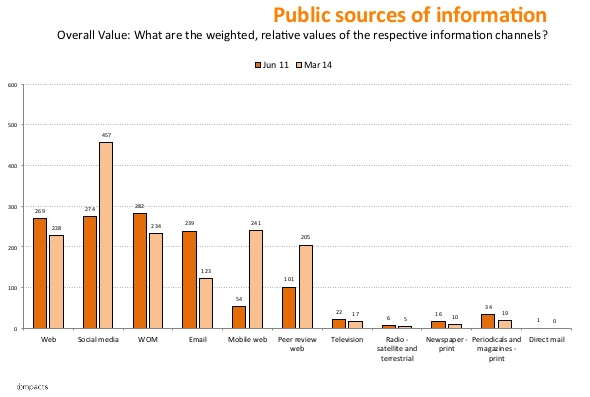The efficacy and best practices related to email as a marketing channel have changed.
Data suggest that email is less effective in reaching large quantities of people than it was even a few short years ago. But, can an organization use email to reach the right quality of people? Maybe.
I recently shared updated data from a Media Consumption and Usage Study conducted by IMPACTS that demonstrated a trending decline in the overall, weighted value of email as a marketing channel.There’s been some additional buzz about the decline of email, and worries about this changing platform seem to be lingering – especially in light of the big data I recently shared at MuseumNext. “I see that there’s a decline in email,” one attendee noted. “Email is working just fine for my organization.”
Indeed, organizations shouldn’t give up on the platform – especially if it is helping their organization achieve its goals – but it’s important to recognize the changes taking place that alter your market’s perceptions and usage of email:
1) The overall efficacy of email as a communication channel for reaching mass audiences has dwindled
It used to be all about email lists – buying them, swapping them, getting people on them – and then “spamming” folks with marketing messages. It was about quantity of people more than the quality of people. Not anymore. Thanks to the increasing and massive trend toward personalization in marketing messages (due, in large part, to “touch points” made possible via social media), email is now a less effective method for engaging large quantities of people. The data indicate that mass messaging holds lesser value to audiences…and we observe people “opting-out” and unsubscribing to content that is not particularly relevant to them.
And folks can afford to opt out because – unlike the earlier days of email – there are much more personalized, real-time information channels promising greater connectivity readily available to them.
2) Email may now be better utilized for cultivating current audiences that already have an affinity for your organization
Email’s relative stability in terms of trust and amplification potential indicate that while it may not be wise for it to be your organization’s primary engagement or audience acquisition channel, it may still offer value by adapting its application to better serve current constituencies. Email should be approached as an “opt-in” opportunity for those who are budding brand evangelists. In other words, this communication method may be better suited for moving potential stakeholders through an engagement funnel instead of as a means to engender general awareness of programs, events, etc.
3) This does not mean that your organization should stop sending emails
Just because a channel’s weighted value is changing doesn’t mean that it’s wise to abandon the platform – especially if it is working for you in terms of helping to meet your financial and mission-related bottom lines. What this does mean is that your email strategy should not be stagnant – when it comes to email, a sound strategy may be to “ride the wave until it crashes.”
Obviously, people still use email; however, they are using it in different ways and expect more personalization than email typically delivered in the past. Know this. Adjust. Watch the market. If something is still working, then, hey, it’s still working! That said, (and as is true with all communication channels) sending email for email’s sake without understanding how or if it is contributing to your goals remains an unwise idea.
4) Start exploring other channels that will help achieve your goals
While it’s not a bad idea to keep “riding the wave [that is email] until it crashes,” it would be advisable to concurrently cultivate engagement on other platforms in preparation for the inevitable crash. Heretofore, if your organization has been relying heavily on email, then it may be a good idea to consider building communities and strategies on other platforms so that you aren’t stuck with antiquated outreach tools that the market deems obsolete. Alternative channels and platforms that capitalize on real-time, ongoing, personalized communication generally involve social media or other web-based platforms…now is the time to start developing capabilities and capacities in these arenas before it’s too late.
5) Understand that email has changed and will keep changing.
Email has maintained its perception in regard to trust (i.e. how trustworthy it is perceived to be as a communications channel) and amplification values (i.e. how easy it is to share the message). You can see the data broken down by reach, trust and amplification here. It makes sense that amplification has not changed as it’s just as easy to hit “forward” today as it was in 2011. As other platforms evolve, how people view and use email will evolve as well. It is not used for the same purpose as it once was thanks to new information channels. The roles of organizations’ websites have also recently changed due to the presence and capabilities of social media. Know that things are changing and the relative strengths of communication channels are certain to keep changing, too.
An exciting aspect of leading an organization in today’s world is the incredible access provided by web-based platforms and how digital assets (and how the market perceives and interacts with them) constantly evolve. Wise organizations realize that the world is moving and it is unwise to maintain the same strategy for communication platforms year after year without considering changes in the market.
In sum, email is not dead…but it has certainly evolved.


